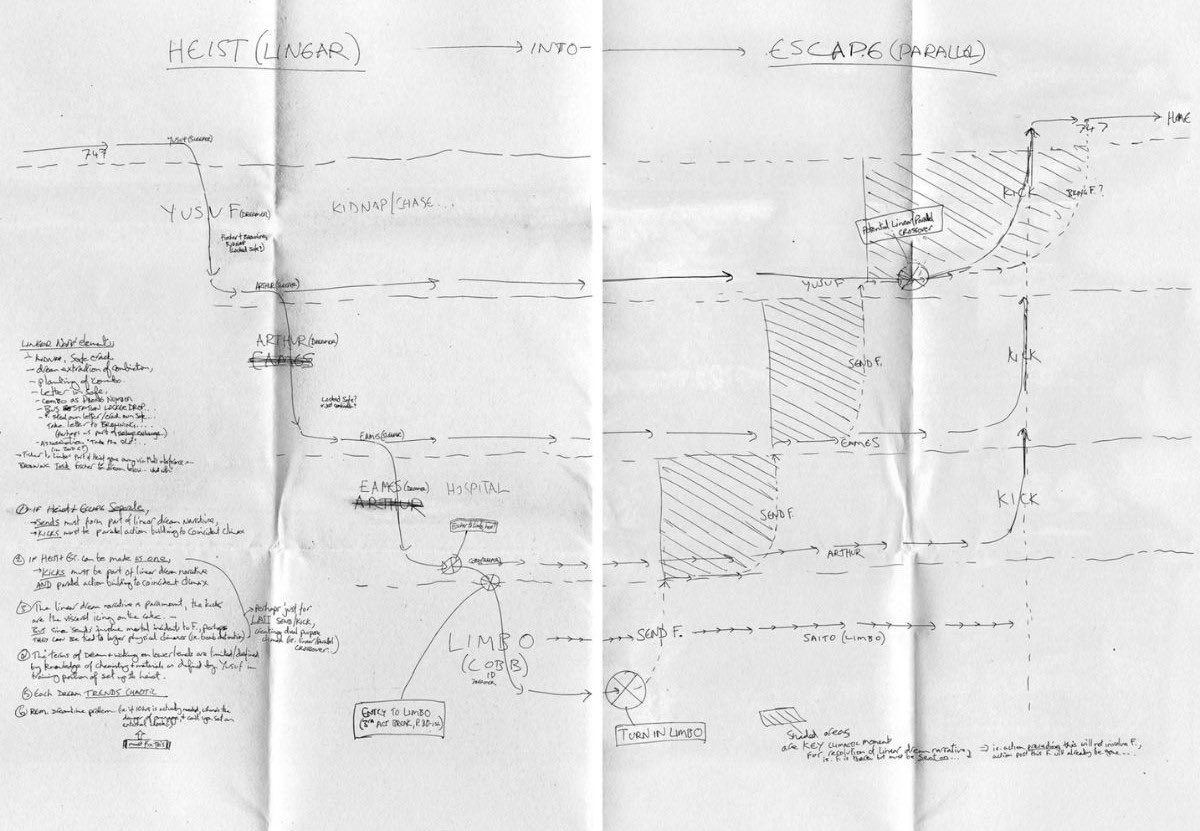With films like Interstellar, Inception, The Prestige, and Tenet, Christopher Nolan delivers mind-bending stories that challenge the audience to expand their thinking. To create these intricate and complex narrations, Nolan doesn’t use detailed outlines. Instead, he “draws shapes and diagrams and other structural things.” He uses plot maps.
A plot map, aka story map or narrative map, is a visual representation or diagram that outlines the key elements and structure of a story or plot. It’s a tool used to organise and visualise the progression of events, characters, and themes within a narrative. For example, this is Nolan’s plot map for the film, Inception:

Inception is one of the most complex mainstream movies ever: it runs 2.5 hours, and made about USD835 billion at the box office. Yet Nolan planned the entire story on a one page map! The plot map isn’t just the shape of his story, it’s also how he designed the world — dreams within dreams.
In storytelling, the idea of structure is everywhere – for example, there’s the 3 Act Structure, StoryGrid, and Hero’s Journey – but Nolan claims those restrict his creativity. He prefers to think in ‘shapes’ rather than in hard rules.
If this ‘map’ looks familiar, you’re probably thinking it’s like one of Vonnegut’s Shape of Stories – particularly the “Man in a Hole” where the main character gets into trouble, and gets out of it again. It’s also one of the most used plotlines in fiction.
However, Nolan doesn’t stick to one style of map. Here’s the plot map for the sequences in Tenet:

Nolan’s approach to storytelling
One of Nolan’s signature storytelling techniques is presenting events out of chronological order. He often employs non-linear narrative structures to create suspense, mystery, and surprise. Plot maps help him visualise the order and timing of events, allowing him to strategically place key plot points and revelations throughout the story.
You’ll notice that his films often feature multiple interwoven storylines that converge at certain points. Plot maps help track these different narrative threads and ensure their coherence. By mapping out the relationships between various characters, events, and timelines, Nolan can carefully manage the pacing and complexity of his films.
Nolan’s movies often delve into deep philosophical concepts and explore themes such as time, memory, identity, and perception. Plot maps can help him identify opportunities for incorporating symbolic elements and thematic motifs. By visualising the progression of the story and its underlying themes, he can craft a more cohesive and thought-provoking narrative.
Plot maps also aid Nolan’s planning and executing grand set pieces and action sequences he is known for. By mapping out the key action beats and moments, he can ensure that the visual spectacle aligns with the emotional beats and narrative progression of the story.
Other directors and their methods
While Nolan uses plot maps for his storylines, other famous directors also incorporate similar tools to enhance their storytelling process.
Quentin Tarantino: Tarantino is known for his non-linear narratives and intricate storytelling. He often uses plot maps or “timeline charts” to visualise the structure of his films like Pulp Fiction and Kill Bill. These maps help him arrange the different storylines and ensure the proper sequencing of events.
Guillermo del Toro: Del Toro is known for his richly imaginative and visually captivating films. He often employs detailed storyboards and visual diagrams to plan out his intricate fantasy worlds and elaborate set pieces. These visual aids help him bring his stories to life and maintain consistency in his storytelling.
Wanna see other auteurs? Check out some of the most iconic figures in our list of awesome directors.











